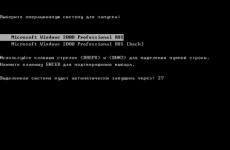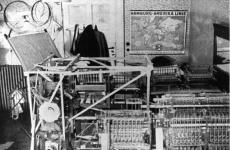Fat32 or ntfs for a flash drive - which format to choose? How to format a flash drive in FAT32 or NTFS? Characteristics of file systems In what cases is the fat32 file system used?
Surely, when formatting a flash drive, many users were lost when choosing a new file system for it. In fact, the average person is unlikely to know how NTFS differs from FAT32. But the differences are quite significant. In this article we will reveal the main differences between these three formats. Of course, there are an order of magnitude more of them, but others, like ext4 and HFS, are irrelevant within the operating system Windows systems, as they are used to work in distributions based on the Linux kernel and Mac OS.
What are NTFS and FAT32?
To understand the difference between NTFS and FAT32, let's try to define them, because not every user understands all the intricacies of a computer system.
So, FAT32 and NTFS are file systems. In turn, the file system is a way to organize all information entering the storage device. Without it, the operating system simply will not be able to interact with all the data on a flash drive or hard drive. The presented file systems, as already noted, are not the only ones of their kind, but are considered current, that is, often used in Windows.
Now let's outline the criteria by which the described file systems can be compared with each other. This is necessary in order to understand how NTFS differs from FAT32. So, there are three main aspects to this issue:
- Compatibility and system requirements.
- Impact on wear of drive chips.
- Limitation on the size and amount of recorded data.
Well, now you can proceed directly to analyzing the question of how the FAT32 system differs from NTFS.
Criterion one: compatibility and system requirements

If you plan to use the flash drive not only for your computer, but also for other multimedia devices, then compatibility is one of the most important criteria for choosing a file system. Let's figure it out in terms of compatibility and system requirements.
- FAT32
FAT32 is the oldest file system presented in this article. Its data organization has been used since the popularity of the MS-DOS operating system. Of the listed systems, it is also the most optimized for all types of devices. That is, you are without special problems you can use it on newfangled devices like latest smartphones Android or play music on old audio players. As for the system requirements, everything is fair here too. FAT32 does not consume a large amount of computer resources and practically does not load the processor.
When the Windows operating system received a new (by those standards) NT architecture, then the NTFS file system was born. Now it is considered standard for all Windows operating systems. However, despite this, you can view it on computers running Mac OS and Linux. But don’t even try to play music from such a flash drive on car radios or second-tier players: with almost one hundred percent probability you won’t succeed. Also smartphones based on Android systems and iOS will refuse to detect the connected drive via an OTG cable. Please also note that the system requirements have increased.
Criterion two: impact on drive wear

We found out how the FAT32 file system differs from NTFS in terms of compatibility, now let's look at the second criterion - the impact on drive wear. The fact is that the Flash memory that any flash drive is equipped with has its own limit, after which it simply stops functioning. It is expressed in the number of permissible overwrites of data cells, that is, the less often the data is overwritten, the longer the flash drive will last.
- FAT32
If you value the durability of your flash drive, then you should avoid this file system. It works great with small and medium-sized files, but despite this, it fragments them quite a lot. Accordingly, the number of rewrites of the same memory cells increases, and the durability of the drive, on the contrary, decreases.
As for NTFS, with this file system the flash drive will last an order of magnitude longer than with FAT32. The developers achieved this by introducing technology for indexing all data, which reduces the number of rewrites of the same memory cells. But there is also a significant drawback - this system works noticeably slower with data.
Criterion three: restrictions

Two criteria have already been discussed, now let’s move directly to the last one and figure out how NTFS differs from FAT32 in terms of the restrictions imposed when using them.
- FAT32
If we talk about the main disadvantages of the FAT32 file system, then these are, undoubtedly, its limitations on data recording. Due to the peculiarities of data organization maximum size The recorded file should not exceed 4 GB. Of course, earlier this figure seemed exorbitant, but now this size is more of a medium size than a large one. There is also an unpleasant point: the root directory of such a system cannot contain more than 512 files. However, it is mitigated by a little trick - if you place the files in directories, the limitation disappears.
If we talk about NTFS, then, turning a blind eye to all the technical aspects, we can say that there are no restrictions on writing data. Of course, they exist, but achieving them in our time is simply unrealistic. This applies to both the size of the recorded file and the number of files in the root directory.

So we figured out what the difference is between the NTFS and FAT32 file systems, and now we can give some recommendations on their choice.
- If you plan to use a flash drive to play media files in old-style players, then it is better to use FAT32.
- If you need to write files to the drive big size, then you definitely need to format the flash drive in NTFS.
- If high speed data recording is required, it is recommended to use FAT32.
- To extend the life of a Flash drive, format it to NTFS.
Conclusion
All the nuances of using the NTFS and FAT32 file systems were discussed above. We hope this article was useful to you and you were able to understand what the differences are between these seemingly two similar systems.
A file system provides a way to organize a disk. It defines how data is stored on disk and what types of information can be attached to files—file names, permissions, and other attributes.
Windows supports three different file systems. NTFS– the most modern file system. Windows uses NTFS for its system disk and, by default, for most fixed disks. FAT32 is an older file system that is not as efficient as NTFS and does not support a large set of features, but provides greater compatibility with other operating systems. exFAT is a modern replacement for FAT32 and is supported by more devices and operating systems than NTFS - but it is not as widespread as FAT32.
NT File System (NTFS)
NTFS is modern file system, which Windows prefers to use by default. During installation, Windows formats the system disk into file format. NTFS systems. NTFS has such huge file size and partition size limits that you are unlikely to ever encounter them. NTFS first appeared in consumer Windows versions XP, although it originally debuted on Windows NT.
NTFS is packed with modern features not available with FAT32 and exFAT. NTFS supports file permissions for security, a change log that can help you quickly recover from errors if your computer crashes, shadow copies for backup copies, encryption, disk quota restrictions, hard links and various other features. Many of them are critical to the operating system disk, especially file permissions.
The Windows system partition must be in NTFS format. If you have an additional drive with Windows and plan to install programs on it, it is better to also format it with NTFS. And, if you have any drives for which compatibility isn't an issue—because you know you'll be using them on Windows systems—feel free to choose NTFS.
Despite its advantages, NTFS lacks compatibility. She will work with everyone latest versions Windows – up to Windows XP – but it has limited compatibility with other operating systems. By default, Mac OS X can only read NTFS drives, but not write data. Some Linux distributions may include NTFS write support, but others may be read-only. None of the Sony PlayStation consoles support NTFS. Even your own Xbox console Microsoft's 360 cannot read NTFS drives other than Xbox One. Other devices are even less likely to support NTFS.
Compatibility: Works with all versions of Windows, but is read-only on Mac, and may be read-only on some Linux distributions. Other devices, with the exception of the Microsoft Xbox One, will likely not support NTFS.
Restrictions: Unrealistic file and partition size limits.
Ideal use: Use this for your Windows system drive and other internal drives that will only be used with Windows.
File Allocation Table 32 (FAT32)
FAT32 is the oldest of the three file systems available in Windows. It was introduced in Windows 95, and replaced the old FAT16 file system used in MS-DOS and Windows 3.
The age of the FAT32 file system has its advantages and disadvantages. The big advantages are that FAT32 is the de facto standard. Flash drives included in the packaging often have the FAT32 file system for maximum compatibility not only with modern computers, but also other devices, such as game consoles and anything with a USB port.
However, its limitations are also related to age. Individual files on a FAT32 disk cannot be larger than 4 GB - this is the maximum. The FAT32 partition must also be smaller than 8 TB. These are the boundaries that modern user devices have come close to.
FAT32 suitable for USB flash drives and other external media - especially if you know you'll be using it on another non-Windows PC. This file system lacks the permissions and other security features built into the more modern NTFS file system. Additionally, modern versions of Windows can no longer be installed on a drive formatted with FAT32; they must be installed on drives formatted with NTFS.
Compatibility: Works with all versions of Windows, Mac and Linux, game consoles, and almost any device with a USB port.
Restrictions: Maximum file size is 4 GB, maximum partition size is 8 TB.
Ideal use: use on removable drives where you need maximum compatibility with wide range devices unless you are using 4GB or larger files.
Extended File Allocation Table (exFAT)
exFAT file system was introduced in 2006 and was added to older versions of Windows with updates for Windows XP and Windows Vista. exFAT is Flash-optimized file system– designed to maintain FAT32 compatibility, but without the extra features of NTFS and without the limitations of FAT32.
Like NTFS, exFAT has very large file and partition size limits, allowing you to store files much larger than the 4 GB allowed by FAT32.
Although exFAT does not exactly match the compatibility of FAT32, it is more widely compatible than NTFS. Even Mac OS offers full exFAT support for reading and writing. exFAT disks can be accessed on Linux after installing the appropriate software. It's a little more complicated with other devices: PlayStation 4 supports exFAT; PlayStation 3 does not support; Xbox One supports it, but Xbox 360 does not.
Compatibility: works with all versions of Windows and modern ones Mac versions X, but requires additional software on Linux. More devices support exFAT, but some - especially older ones - only work with FAT32.
Restrictions: Unrealistic file and partition size limits.
Ideal use: Use it when you need to store large files and when you need wide compatibility. Assuming every device you want to use supports exFAT, you should format your device with exFAT instead of FAT32.
NTFS is ideal for internal drives, while exFAT is usually ideal for flash drives. However, sometimes you may need to format external drive using FAT32 if exFAT is not supported on the device you want to use it with.
Selecting a file system for regular user becomes relevant when formatted hard drive, flash drive or other storage medium. The system offers several options: FAT16, FAT32, exFAT, NTFS. Almost nothing is known about the advantages and disadvantages of each, so they often choose what is well-known - as a rule, this is NTFS. To be fair, it is worth clarifying that FAT16 today is more of a memory, and formatting media into it is done only as an experiment. The exFAT system, due to its still insignificant distribution, can also be considered, if not an exclusive, then not a universal solution - not all operating systems support it. So the choice is between two abbreviations - FAT32 and NTFS.
FAT32- a file system created on the basis of FAT16. Essentially, this file system is a file layout spreadsheet using 32-bit records. By the way, the abbreviation stands for File Allocation Table.
NTFS- a file system, which is a certain structure: at the beginning of the disk there is a summary table (or directory) of all files, then - the data itself. The abbreviation stands for New Technology File System.
In practice today, the FAT32 file system is more often used on removable media small volume, NTFS - on system drives and for storing large files. FAT32 clusters are larger, hence disk space When storing a large number of small files, it is used irrationally. A large number of programs that require, for example, many libraries, font files and others, will respond to the FAT32 system slow work. NTFS provides fast access to a small file or part of a file.
In general, NTFS is noticeably slower than FAT32, but NTFS is more efficient when accessing large files. Fragmentation does not affect NTFS in any way, while FAT32 will noticeably reduce performance (especially when working with medium-sized directories).
Speaking of hardware work tough disks, then FAT32 will provide a gentle mode for them: when reading, the head makes fewer movements, and accordingly, the degree of mechanical wear will be less. However, the relevance of this property is lost in light of the negligible use of the FAT32 file system on hard drives in systems. The design of flash drives and memory cards does not imply mechanical wear.
Working with the NTFS file system requires a significant amount of space random access memory, so weak systems with RAM less than 64 MB are not designed for it. Although at present such assemblies can only be found in museums or created for the sake of experimentation. However, it is worth remembering that the FAT32 system does not impose requirements on the amount of RAM, especially if you take into account the option of expanding the standard memory mobile devices. The phone simply will not be able to work with a memory card formatted in NTFS, even if access is possible from the operating system.
The maximum file size in FAT32 is 4 GB. NTFS theoretically supports files of about 16 TB in size. The theoretical maximum disk size for FAT32 is 8 TB, while for NTFS it is about 16 exabytes. True, technology has not yet reached the point of using these properties in practice.
Another undoubted advantage of NTFS is the ability to compress a file at the file system level. We can also talk about more high level system reliability, and, in addition, the ability to save the file structure in NTFS in the event of a failure.
Conclusions website
- NTFS uses disk space more efficiently.
- FAT32 is faster.
- NTFS provides high performance when working with large files.
- FAT32 supports files up to 4 GB in size.
- FAT32 does not require a lot of RAM.
- NTFS ensures high system reliability.
NTFS, FAT or exFAT are completely different file systems that can be used to store data on different media. Both were created by Microsoft and are mainly used for Windows, but they are also supported in the Linux kernel.
Most often, NTFS is used to install the Windows operating system or Windows partitions for files, while FAT is often used on flash drives or other external storage devices. Also, FAT can often be used as the main file system for Android. In this article we will look at the differences between FAT and NTFS, we will analyze in detail how they differ and why they are needed.
The file system sets the basic rules for how data will be organized when written to the storage medium, regardless of what it is - HDD or flash drive. The file system describes how folders will be organized.
A specific piece of data called a file is located in desired area drive. The file system performs all the necessary calculations, and also determines the minimum indivisible size of a data block, the maximum file size, and monitors fragmentation. There are many various types file systems, these are, for example, file systems for installing an OS, for external media, for optical disks,distributed file systems. But in this article we will only perform fat comparison and ntfs.
What is the FAT file system?
File systems fat32 and ntfs are very different. FAT stands for File Allocation Table. This is a very old file system in the history of computing systems. Its story began in 1977. Then an 8-bit file system was developed, which was used in the NCR 7200 based on the Intel 8080. It was an input terminal that worked with floppy disks. The file system was written by Microsoft employee Mark McDonald after discussing the concept with Bill Gates.
Then the FAT file system began to be used in operating system MDOS for the Z80 platform. A few years later, new versions were released such as FAT12, FAT16 and FAT32.
FAT32 increased the maximum volume size to 16 TB, compared to FAT16. The file size has also been increased to 4 GB. File Allocation Table 32 bit was released in August 1995 for Windows 95. But this file system still cannot be used for installing heavy applications or storing large files. Therefore, Microsoft has developed a new file system - NTFS, which is devoid of such shortcomings.
FAT32 is an excellent file system for external media if you need to transfer files no larger than 4 GB. It is supported by many various devices, such as cameras, cameras, music players. All versions of Windows and Linux distributions fully support FAT32. Even Apple MacOS supports it.
What is the NTFS file system?
For your new ones Microsoft systems developed a new file system - New Technology File System or NTFS. It appeared in 1993, in Windows NT 3.1. NTFS removed many restrictions on file and disk sizes. Its development began back in 1980, as a result of the merger of Microsoft and IBM to create a new file system with improved performance.
But the cooperation between the companies did not last long, and IBM released HPFS, which was used in OS/2, and Microsoft created NTFS 1.0. The maximum size of a single file in NTFS can reach 16 exabytes, which means that even the largest files will fit in it.
NTFS 3.1 was released for Windows XP and received many interesting improvements such as support for partition size reduction, automatic recovery and symbolic links, and the maximum file system disk size was increased to 256 TB. This is despite the maximum file size of 16 EB.

Other interesting features that were added later include lazy disk writes, defragmentation support, disk quota settings, link tracking, and file-level encryption. With all this, NTFS remains compatible with previous versions.
Now this is a journaled file system; all actions with files are recorded in a special journal, with the help of which the file system can be very quickly restored if damaged. NTFS supported on Windows XP and later later versions. If we compare fat or ntfs, the latter is not fully supported in Linux; writing and recovery in case of damage are possible, but in MacOS only reading is supported.
What is exFAT file system?
The exFAT file system is another Microsoft project to improve the old file system. It can be striped where FAT32 does not fit. It is much lighter than NTFS, but supports files larger than 4 GB, and is also often used on flash drives and drives. When developing it, Microsoft used its technology for searching file names by hash, which greatly improves performance.
Most countries recognize US patent law, so any implementation of exFAT is not possible on any closed or open source systems. But Microsoft wants this file system to be freely distributed and used. Therefore, a FUSE-based version of exFAT called fuse-exfat was developed. It gives full read and write access. An implementation at the Linux kernel level was also created at Samsung, which is now also publicly available.
This file system also has a maximum file size limit of 16 EB, but it is much lighter and does not have any additional features. If we talk about compatibility, it is fully supported on Windows, MacOS, Android and Linux.
Differences between FAT and Ntfs
Now let's look at the main differences between FAT and NTFS in the form of a brief summary of each file system:
FAT32
- Compatibility: Windows, Mac, Linux, game consoles, almost all devices with a USB port;
- Pros: cross-platform, lightweight;
- Minuses: maximum file size 4 GB and partition size 16 GB, non-journaling;
- Usage: external media.
NTFS
- Compatibility: Windows, Linux, Xbox One, and read-only on Mac;
- Pros: journaled, large limits on partition and file size, encryption, automatic recovery;
- Minuses: limited cross-platform;
- Usage: to install Windows.
exFAT
- Compatibility: Windows XP and higher, MacOS X 10.6.5, Linux (fuse), Android;
- Pros: large limit on partition and file size, lightweight compared to NTFS;
- Minuses: Microsoft limits its use to a license agreement;
- Usage: for external media and external hard drives.
conclusions
In this article we have made a comparison between fat and ntfs. These are very different file systems. But it is difficult to understand which file system is better than fat or ntfs; on the one hand, NTFS has many more capabilities, but FAT is lighter and is supported wherever possible. For data partitions in Linux that need to be accessible in Windows is better use FAT rather than NTFS as it is better supported. What do you think is better fat or ntfs for Linux?
How to change ntfs to fat32? What is the correct format to use for a FAT32 or NTFS flash drive? All this will be discussed below.
By and large, both formats can be used, FAT32 and NTFS. It all depends on how you are going to use the flash drive.
When buying a new flash drive, as a rule, they have the FAT32 file system and this is not surprising, since this file system is readable from many devices, something like a universal format. Well, there are opinions that this format is more productive than NTFS.
You may encounter difficulties only when you need to transfer a file larger than 4GB onto a flash drive. There may be other errors, too, but these are usually special cases.
For example, you go to install windows from a flash drive. If your flash drive is in FAT32 format, then when you try to write a large file (more than 4GB) to it, Windows itself will give you an error that the file is too large.
Well, when recording an image, you will be asked to format the flash drive or you will also receive an error.
Therefore, before recording windows image or before moving to a flash drive large file, first format your flash drive to NTFS format.
And, of course, you have a reasonable question: which file system to choose for a flash drive, FAT32 or NTFS.
Today, flash drives already come with a large capacity, 32 GB and 64 GB or more. Accordingly, if you buy flash drives with such volumes, you probably plan to throw both movies and large files onto it.
For such purposes, format the flash drive in NTFS and use it as you wish.
If you do not plan to put large files on the flash drive, but plan to use it for documents, photos or small files, for example, music files, then formatting is not necessary.
When choosing a file system for a flash drive, first think about how you will use it, and from there choose the format.
In addition:
How to change fat32 to ntfs or ntfs to fat32 on a flash drive
If for some reason, you have previously formatted a flash drive from fat32 to ntfs and now you need to return everything back from fat32 to convert ntfs or vice versa, then to change to the fat32 or ntfs file system you need, follow these steps:
1. Insert the USB flash drive into your computer/laptop.
2. When the computer detects your device, select the flash drive and right-click, in the menu that opens, click formatting, then select the desired file system format and click start.
After the operation is completed, your flash drive will be in the file system you need.
Attention! Before formatting a flash drive into another format, if there is data on it, first transfer (copy) the files to another location. When formatting, all data from the flash drive is deleted!






